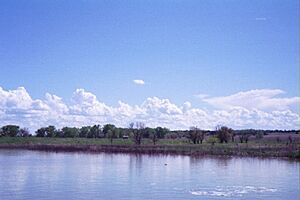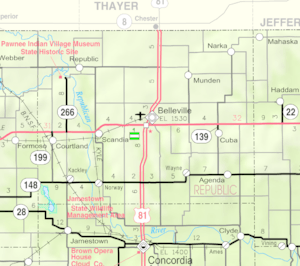Jamestown Wildlife Area facts for kids
The Jamestown Wildlife Area is a large nature spot in Northern Kansas. It covers about 3,239 acres (13.11 square kilometers). You can find it mostly in Republic County, Kansas and partly in Cloud County, Kansas. To get there, drive 5 miles (8 km) North and 2 miles (3.2 km) West of Jamestown. Local people often call this place "Jamestown Lake."
This area is a popular place for outdoor activities. Many people come here for both hunting and fishing. The lake and its surrounding lands are cared for by the Kansas Department of Wildlife and Parks.
Contents
Jamestown Wildlife Area: A Nature Spot in Kansas
The Jamestown Wildlife Area is a special place for nature lovers. It includes different types of land. There are wetlands, which are marshy areas usually covered with shallow water. There are also uplands, which are higher, drier areas. This mix of land types makes it a great home for many animals.
The Kansas Department of Wildlife and Parks has managed this area since 1932. Two of the larger marsh areas were once sold. The money from this sale helped fund Emporia State Teachers College.
Fun Activities: Hunting and Fishing
The Jamestown Wildlife Area is well-known for its outdoor fun. Many visitors enjoy hunting different types of game. Others love to fish in the lake. The Kansas Department of Wildlife and Parks works hard to keep the area healthy. This ensures that both animals and visitors can enjoy the space safely.
A Look Back: History of the Area
The Jamestown Wildlife Area has a long and interesting history. It was once a "salty" marshy area. This means the water and soil had a lot of salt. During dry times, salt would even appear on the ground. When it rained, the area filled with water. This attracted many different kinds of wildlife.
Early Days and Native Americans
For a long time, these marshes were very important. Native Americans visited the area often. Early settlers also found it useful. Huge herds of bison came here to drink. Large flocks of waterfowl and other animals also used the marshes. It was a vital stop for migrating animals.
Building Dams for Recreation
In the early 1900s, local people wanted a more steady water supply. They built dams on the lower parts of both large marshes. These dams helped to keep the water level higher. This made the area even better for recreation. It allowed people to enjoy activities like boating and fishing more often.



